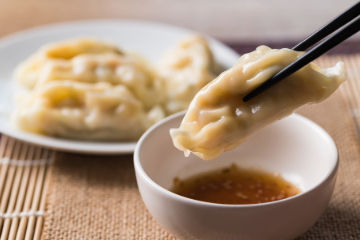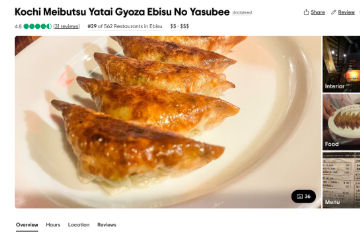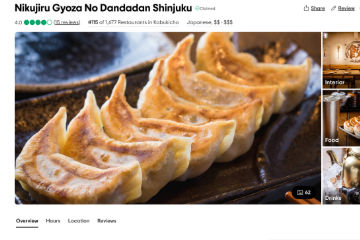Gyoza (Japanese Dumplings): A Delicious Guide to Japan’s Crispy, Juicy Favorite
- Patia

- Jul 1
- 6 min read

HELLO, I'M AYU!
I am one of the staff members at Patia, where we offer cooking classes specifically designed for foreign tourists in Tokyo. I have two children, and I love cooking! I look forward to sharing my passion for cooking with you and making your experience in Japan truly memorable!

Crispy on the outside, juicy on the inside—gyoza (Japanese dumplings) are a must-try for food lovers visiting Japan.
These savory dumplings, inspired by Chinese jiaozi but uniquely Japanese in flavor and style, have become a staple in homes, restaurants, and street food stalls across the country. Whether you’re searching for the best gyoza in Tokyo or want to try making them at home, this guide will take you through everything you need to know—from the history of gyoza and the different types you’ll find in Japan, to an easy step-by-step recipe and local tips.
Let’s explore the delicious world of Japanese gyoza dumplings!
Table of Contents
What Are Gyoza (Japanese Dumplings)?
Gyoza (餃子) are Japanese dumplings typically filled with minced pork, cabbage, garlic, and ginger. They are wrapped in a thin dough and pan-fried until the bottom is golden and crispy, then steamed to create a deliciously soft and chewy top.
There are several types of gyoza in Japan:
Yaki-gyoza (pan-fried, the most common)

This is the most popular style of gyoza in Japan. The dumplings are first pan-fried on one side until they develop a crispy, golden-brown bottom, then steamed with a splash of water and covered until the wrappers become tender. The result is a perfect contrast between the crispy base and the juicy interior — a must-try for first-time gyoza eaters.
Sui-gyoza (boiled)

Sui-gyoza are boiled dumplings, known for their soft and silky texture. Unlike the crispy yaki-gyoza, these are cooked gently in water or broth and are often served in soups or with light dipping sauces. They're lighter on the palate and often considered a healthier option, perfect for those looking for something a bit more delicate.
Age-gyoza (deep-fried)

Age-gyoza are deep-fried dumplings with a crunchy exterior and juicy filling inside. This version is crispier and richer than the others, offering a satisfying crunch with each bite. Age-gyoza are commonly found at izakayas (Japanese pubs) and make for a delicious appetizer or snack alongside a cold drink.
The Rise of Gyoza in Japan: From Home Kitchens to National Favorite

Gyoza has become one of the most popular everyday foods in Japan. Originally spreading through home kitchens in the mid-20th century, gyoza quickly gained popularity for being easy to prepare, affordable, and incredibly delicious. The dish soon found its way into casual restaurants, school lunches, and even convenience stores.
Today, gyoza is enjoyed in a variety of settings across Japan. From homemade family dinners to gyoza specialty shops, this crispy and juicy dumpling has captured the hearts of people of all ages. Some cities, like Utsunomiya in Tochigi Prefecture and Hamamatsu in Shizuoka, are especially famous for their regional gyoza styles—and even host annual gyoza festivals.
Modern gyoza comes in many varieties. While the classic filling includes ground pork, cabbage, and garlic, you'll also find creative options like shrimp gyoza, cheese gyoza, or even vegetarian gyoza made with tofu and vegetables. Some restaurants even offer soup gyoza or deep-fried versions for a new twist on the classic.
Whether pan-fried, boiled, or served in a hot pot, gyoza has become more than just a side dish—it's a symbol of Japanese comfort food culture.
Where to Eat Gyoza in Tokyo: 5 Must-Try Dumpling Spots for Visitors
If you’re visiting Japan and want to taste one of its most beloved comfort foods, gyoza should be at the top of your list. These Japanese dumplings are crispy, juicy, and packed with savory flavor — and they’re found everywhere from casual eateries to stylish modern bars.
To help you find the best spots during your Tokyo adventure, here are 5 popular gyoza restaurants in Tokyo that are perfect for international visitors. Whether you’re a first-timer or a dumpling enthusiast, these places offer great flavor and a memorable local experience.
1. Harajuku Gyozaro – Casual, Delicious, and Close to Shopping

Harajuku Gyozaro is known for its bite-sized dumplings with crispy skins and juicy meat fillings. The prices are affordable, and the casual, welcoming vibe makes it a favorite among locals and tourists alike. Expect a line—visiting with some extra time is recommended.
Price:
Gyoza (1 serving): ¥340
Access:
2-minute walk from Meiji-Jingumae Station (Fukutoshin Line), Jingumae Crossing Exit
Hours:
11:30 AM – 10:30 PM
2. Ebisu no Yasubee – Crispy Gyoza with a Street Food Feel

Yasubee in Ebisu serves crispy, thin-skinned dumplings that are easy to enjoy in bite-sized pieces. Garlic is optional, making it a popular spot among female diners. The shop brings the lively atmosphere of Kochi’s street food scene to Tokyo.
Price:
Gyoza (1 serving): ¥560
Access:
5-minute walk from JR Ebisu Station
Hours:
Weekdays: 4:00 PM – 12:00 AM
Weekends & Holidays: 3:00 PM – 12:00 AM
3. Gyoza no Osama – Michelin-Recognized Gyoza in Asakusa

Gyoza no Osama (The King of Gyoza) is famous for its crispy dumplings filled with vegetables that bring out a natural sweetness. This Asakusa favorite has earned a spot in the Michelin Guide’s Bib Gourmand for three consecutive years.
Price:
Gyoza (1 serving): From ¥490
Access:
3-minute walk from Asakusa Station (Ginza Line, Exit 6)
4-minute walk from Asakusa Station (Tobu Skytree Line)
Hours:
Lunch: 11:15 AM – 2:30 PM
Dinner: 4:00 PM – 8:30 PM
Closed on Tuesdays
4. Nikujiru Gyoza no Dandadan (Shinjuku) – Juicy and Bold Flavors

At Dandadan in Shinjuku, the gyoza are packed with meat juices that burst with flavor. The chewy skins and hearty pork and vegetable filling make each bite satisfying. The flavor is rich enough that many customers skip the dipping sauce altogether.
Price:
Gyoza (1 serving): ¥614
Access:
5-minute walk from Shinjuku Station
3-minute walk from Shinjuku Sanchome Station
Hours:
3:00 PM – 4:00 AM
5. VEGAN GYOZA YU COFFEE – 100% Plant-Based and Guilt-Free

Perfect for vegan diners, this specialty shop offers gyoza made without animal products, artificial colors, MSG, additives, or alcohol. The dumplings are filled with seasoned soy meat and are so flavorful you won’t even need dipping sauce.
Price:
Vegan Gyoza Sampler (11 varieties): ¥1,700
Access:
4-minute walk from Uguisudani Station (JR Line)
7-minute walk from Iriya Station (Hibiya Line)
Hours:
Wednesday – Sunday: 12:00 PM – 9:00 PM
Closed on Mondays and Tuesdays
YouTube : How to Make Japanese Gyoza at Home
Homemade gyoza are easier than you might think—and just as delicious as the ones at your favorite restaurant! Whether you're a beginner or a seasoned home cook, this video gives you step-by-step guidance on how to make crispy, juicy yaki gyoza right in your own kitchen.
In this helpful tutorial from the beloved YouTube channel Cooking with Dog, you'll learn how to:
Prepare the perfect gyoza filling with pork and vegetables
Wrap dumplings like a pro
Cook them until golden and crispy on the bottom
It's a great introduction to Japanese home cooking, and the friendly narration makes it easy to follow along.
Watch the full video here:
Channel: Cooking with Dog
Why not try making your own gyoza before (or after!) visiting one of Tokyo’s best gyoza restaurants?
Why Gyoza Should Be on Your Must-Try List in Japan
Whether pan-fried, boiled, or deep-fried, gyoza are a delicious and essential part of Japanese food culture. Easy to find and endlessly customizable, they’re loved by locals and visitors alike. From traditional family recipes to trendy modern twists, every bite tells a story of comfort, creativity, and culinary tradition.
If you’re planning a trip to Tokyo or anywhere in Japan, don’t miss the chance to try authentic Japanese gyoza — or better yet, learn to make them yourself in a local cooking class. It’s a delicious way to connect with Japanese culture, one dumpling at a time.
For Those Interested in Exploring Other Japanese Cuisine: "Patia’s Japanese Cooking Classes"
In this blog post, we introduced Japanese gyoza, including a simple recipe you can try at home and a list of recommended gyoza spots to visit in Tokyo.
We also offer a variety of hands-on Japanese cooking classes, such as wagyu sushi making, ramen from scratch, and creating cute character bento (kyaraben) that reflect Japanese culture.
If you're looking for a unique culinary experience in Japan, be sure to check out our other classes!
We share behind-the-scenes moments, cooking tips, and beautiful photos from our classes on Instagram! Follow us and join the Tokyo food adventure.
Find us on Instagram @patiajapanesecooking
Contact Us
If you have any questions or want to learn more about our cooking classes, feel free to get in touch! We’re here to help you create unforgettable culinary experiences during your stay in Japan.




